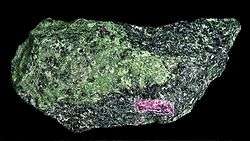Anyolite

Although anyolite is advertised as a variety of the mineral zoisite from Kenya and the Arusha Region of Tanzania, anyolite is actually a metamorphic rock composed of intergrown green zoisite, black/dark green pargasite (erroneously identified as tschermakite), and ruby.[1][2] The term anyolite is however not an officially accepted term for a metamorphic rock.[3] It is said to be named after the Maasai word anyoli, meaning "green." Anyolite is also referred to as ruby in zoisite or Tanganyika artstone.
The contrasting colours make anyolite a popular material for sculptures and other decorative objects. It was first discovered at the Mundarara Mine, near Longido, Tanzania in 1954.
In 2010 it was suggested that a 2 kilogram stone known as the Gem of Tanzania owned by the defunct company Wrekin Construction and fraudulently valued at £11 million was actually a lump of Anyolite worth about £100,[4] although it was eventually sold for £8000.[5]
References
- ↑ http://www.mindat.org/min-27151.html Mindat
- ↑ http://www.cst.cmich.edu/users/dietr1rv/zoisite.htm Gemrocks
- ↑ Metamorphic rocks, A classification and glossary of terms, D. Fettes and J. Desmons ed., Cambridge University Press
- ↑ Jonathan Guthrie (October 1, 2009). "Now £11m Gem of Tanzania hits rock bottom". Financial Times.
- ↑ "Wrekin's '£11m' Gem of Tanzania ruby sold for £8k". BBC News. 16 February 2010.
External links
- Jonathan Guthrie (December 17, 2009). "Ruby rises from rock bottom". Financial Times. Archived from the original on January 28, 2010. Retrieved 2010-01-17.
| Wikimedia Commons has media related to Anyolite. |